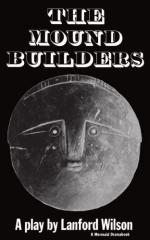Some twenty miles above the mound on the Rainy River at Fort Frances a copper chisel buried in the earth was found by Mr. Pither, then H. B. Company agent, and was given by him to the late Governor McTavish. The chisel was ten inches long, was well tempered, and was a good cutting instrument. Another copper implement is in the possession of our Society, which was found buried in the earth 100 miles west of Red River.
All these, I take it, were made from copper obtained from Isle Royale on Lake Superior.
4. Shell Ornaments. Traces are found in the mound, of the fact that the decorative taste, no doubt developed in all ages, and in all climes, was possessed by the Takawgamis.
(a.) Sea Shells. Important as pointing to the home and trading centres of the mound builders is the presence among the debris of the mound, of sea shells. We have three specimens found in the grand mound. Two of them seem to belong to the genus Natica, the other to Marginella. They have all been cut or ground down on the side of the opening of the shell, so that two holes permit the passage of a string, by which the beads thus made are strung together. The fact that the genera to which the shells belong are found in the sea, as well as their highly polished surface show these to be marine; and not only so but from the tropical seas, either we suppose from the Gulf of Mexico or from the Californian coast.
(b.) Fresh Water Shells. In all the mounds yet opened, examples of the Unio, or River Mussel, commonly known as the clam have been found. They are usually polished, cut into symmetrical shapes, and have holes bored in them. We have one which was no doubt used as a breast ornament, and was hung by a string around the neck. In the bottom of a nearly complete pottery cup, found in the grand mound, which went to pieces as we took it out, there was lying a polished clam shell. The clam still abounds on Rainy River. Six miles above the mound, we saw gathered together by an industrious housewife hundreds of the same species of clam, whose shells she was in the habit of pulverizing for the benefit of her poultry.
5. Pottery. (a.) Broken. It seems to be a feature of every mound that has been opened that fragments of pottery have been unearthed. The Society has in its possession remains of twenty or thirty pottery vessels. They are shown to be portions of different pots, by their variety of marking. The pottery is of a coarse sort, seemingly made by hand and not upon a wheel, and then baked. The markings were made upon the soft clay, evidently with a sharp instrument, or sometimes with the finger nail. Some pieces are found hard and well preserved; others are rapidly disintegrating. As stated already, in the grand mound, a vessel some five inches in diameter was dug up by one of the workers, filled with earth, which though we tried earnestly to save it, yet went to pieces in our hands. The frequency with which fragments of pottery are found in the mounds has given rise to the theory that being used at the time of the funeral rites the vessel was dashed to pieces as was done by some ancient nations in the burial of the dead. This theory is made very doubtful indeed by the discovery of the




